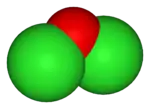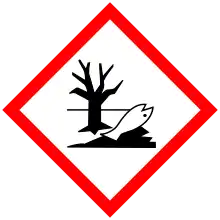 | |
 | |
| Names | |
|---|---|
| Other names
Oxygen dichloride Oxygen chloride Dichlorine oxide Chlorine (I) oxide Hypochlorous oxide Hypochlorous anhydride | |
| Identifiers | |
3D model (JSmol) |
|
| ChEBI | |
| ChemSpider | |
| ECHA InfoCard | 100.029.312 |
PubChem CID |
|
| UNII | |
CompTox Dashboard (EPA) |
|
| |
| |
| Properties | |
| Cl2O | |
| Molar mass | 86.9054 g/mol |
| Appearance | brownish-yellow gas |
| Melting point | −120.6 °C (−185.1 °F; 152.6 K) |
| Boiling point | 2.0 °C (35.6 °F; 275.1 K) |
| very soluble, hydrolyses 143 g Cl2O per 100 g water | |
| Solubility in other solvents | soluble in CCl4 |
| Structure | |
| 0.78 ± 0.08 D | |
| Thermochemistry | |
Std molar entropy (S⦵298) |
265.9 J K−1 mol−1 |
Std enthalpy of formation (ΔfH⦵298) |
+80.3 kJ mol−1 |
| Hazards | |
| GHS labelling: | |
  | |
| Danger | |
| H290, H314, H400, H411 | |
| P234, P260, P264, P273, P280, P301+P330+P331, P303+P361+P353, P304+P340, P305+P351+P338, P310, P311, P321, P363, P390, P391, P405, P406, P501 | |
| NFPA 704 (fire diamond) | |
| Safety data sheet (SDS) | [1] |
| Related compounds | |
Other cations |
|
Related compounds |
Oxygen difluoride, nitrous oxide, chlorine dioxide |
Except where otherwise noted, data are given for materials in their standard state (at 25 °C [77 °F], 100 kPa).
Infobox references | |
Dichlorine monoxide is an inorganic compound with the molecular formula Cl2O. It was first synthesised in 1834 by Antoine Jérôme Balard,[2] who along with Gay-Lussac also determined its composition. In older literature it is often referred to as chlorine monoxide,[3] which can be a source of confusion as that name now refers to the ClO• radical.
At room temperature it exists as a brownish-yellow gas which is soluble in both water and organic solvents. Chemically, it is a member of the chlorine oxide family of compounds, as well as being the anhydride of hypochlorous acid. It is a strong oxidiser and chlorinating agent.
Preparation
The earliest method of synthesis was to treat mercury(II) oxide with chlorine gas.[3] However, this method is expensive, as well as highly dangerous due to the risk of mercury poisoning.
- 2 Cl2 + HgO → HgCl2 + Cl2O
A safer and more convenient method of production is the reaction of chlorine gas with hydrated sodium carbonate at 20–30 °C.[3]
- 2 Cl2 + 2 Na2CO3 + H2O → Cl2O + 2 NaHCO3 + 2 NaCl
- 2 Cl2 + 2 NaHCO3 → Cl2O + 2 CO2 + 2 NaCl + H2O
This reaction can be performed in the absence of water but requires heating to 150–250 °C; as dichlorine monoxide is unstable at these temperatures[4] it must therefore be continuously removed to prevent thermal decomposition.
- 2 Cl2 + Na2CO3 → Cl2O + CO2 + 2 NaCl
Structure
The structure of dichlorine monoxide is similar to that of water and hypochlorous acid, with the molecule adopting a bent molecular geometry (due to the lone pairs on the oxygen atom) and resulting in C2V molecular symmetry. The bond angle is slightly larger than normal, likely due to steric repulsion between the bulky chlorine atoms.
In the solid state, it crystallises in the tetrahedral space group I41/amd, making it isostructural to the high pressure form of water, ice VIII.[5]
Reactions
Dichlorine monoxide is highly soluble in water,[6] where it exists in an equilibrium with HOCl. The rate of hydrolysis is slow enough to allow the extraction of Cl2O with organic solvents such as CCl4,[3] but the equilibrium constant ultimately favours the formation of hypochlorous acid.[7]
- 2 HOCl ⇌ Cl2O + H2O K (0 °C) = 3.55x10−3 dm3/mol
Despite this, it has been suggested that dichlorine monoxide may be the active species in the reactions of HOCl with olefins and aromatic compounds,[8][9] as well as in the chlorination of drinking water.[10]
With inorganic compounds
Dichlorine monoxide reacts with metal halides, with the loss of Cl2, to form unusual oxyhalides.[11][12][3]
Similar reactions have also been observed with certain inorganic halides.[13][14]
With organic compounds
Dichlorine monoxide is an effective chlorinating agent. It can be used for either the side-chain or ring chlorination of deactivated aromatic substrates.[15] For activated aromatics such as phenols and aryl-ethers it primarily reacts to give ring halogenated products.[16] It has been suggested that dichlorine monoxide may be the active species in the reactions of HOCl with olefins and aromatic compounds.[8][9]
Photochemistry
Dichlorine monoxide undergoes photodissociation, eventually forming O2 and Cl2. The process is primarily radical based, with flash photolysis showing radical hypochlorite (ClO·) to be a key intermediate.[17]
- 2 Cl2O → 2 Cl2 + O2
Explosive properties
Dichlorine monoxide is explosive, although there is a lack of modern research into this behaviour. Room temperature mixtures with oxygen could not be detonated by an electric spark until they contained at least 23.5% Cl2O[18] which is an exceedingly high minimum explosive limit. There are conflicting reports of it exploding on exposure to strong light.[19][20] Heating above 120 °C, or a rapid rate of heating at lower temperatures also apparently lead to explosions.[3] Liquid dichlorine monoxide has been reported to be shock-sensitive.[21]
References
- ↑ "CHLORINE MONOXIDE". CAMEO Chemicals. National Oceanic and Atmospheric Administration. Retrieved 12 May 2015.
- ↑ Balard, A.J. (1834). "Recherches sur la nature des combinaisons décolorantes du chlore" [Investigations into the nature of bleaching compounds of chlorine]. Annales de Chimie et de Physique. 2nd series (in French). 57: 225–304.
- 1 2 3 4 5 6 Renard, J. J.; Bolker, H. I. (1 August 1976). "The chemistry of chlorine monoxide (dichlorine monoxide)". Chemical Reviews. 76 (4): 487–508. doi:10.1021/cr60302a004.
- ↑ Hinshelwood, Cyril Norman; Prichard, Charles Ross (1923). "CCCXIII.—A homogeneous gas reaction. The thermal decomposition of chlorine monoxide. Part I". Journal of the Chemical Society, Transactions. 123: 2730–2738. doi:10.1039/CT9232302730.
- ↑ Minkwitz, R.; Bröchler, R.; Borrmann, H. (1 January 1998). "Tieftemperatur-Kristallstruktur von Dichlormonoxid, Cl2O". Zeitschrift für Kristallographie. 213 (4): 237–239. Bibcode:1998ZK....213..237M. doi:10.1524/zkri.1998.213.4.237.
- ↑ Davis, D. S. (1942). "Nomograph for the Solubility of Chlorine Monoxide in Water". Industrial & Engineering Chemistry. 34 (5): 624. doi:10.1021/ie50389a021.
- ↑ Aylett, founded by A.F. Holleman; continued by Egon Wiberg; translated by Mary Eagleson, William Brewer; revised by Bernhard J. (2001). Inorganic chemistry (1st English ed., [edited] by Nils Wiberg. ed.). San Diego, Calif. : Berlin: Academic Press, W. de Gruyter. p. 442. ISBN 9780123526519.
{{cite book}}: CS1 maint: multiple names: authors list (link) - 1 2 Swain, C. Gardner; Crist, DeLanson R. (1 May 1972). "Mechanisms of chlorination by hypochlorous acid. The last of chlorinium ion, Cl+". Journal of the American Chemical Society. 94 (9): 3195–3200. doi:10.1021/ja00764a050.
- 1 2 Sivey, John D.; McCullough, Corey E.; Roberts, A. Lynn (1 May 2010). "Chlorine Monoxide (Cl2O) and Molecular Chlorine (Cl2) as Active Chlorinating Agents in Reaction of Dimethenamid with Aqueous Free Chlorine". Environmental Science & Technology. 44 (9): 3357–3362. Bibcode:2010EnST...44.3357S. doi:10.1021/es9038903. PMID 20302364.
- ↑ Powell, Steven C. (1 May 2010). "The active species in drinking water chlorination: the case for Cl2O". Environmental Science & Technology. 44 (9): 3203. Bibcode:2010EnST...44.3203P. doi:10.1021/es100800t. PMID 20302368.
- ↑ Oppermann, H. (1967). "Untersuchungen an Vanadinoxidchloriden und Vanadinchloriden. I. Gleichgewichte mit VOCl3, VO2Cl und VOCl2". Zeitschrift für anorganische und allgemeine Chemie. 351 (3–4): 113–126. doi:10.1002/zaac.19673510302.
- ↑ Dehnicke, Kurt (1961). "Titan(IV)-Oxidchlorid TiOCl2". Zeitschrift für anorganische und allgemeine Chemie. 309 (5–6): 266–275. doi:10.1002/zaac.19613090505.
- ↑ Dehnicke, Kurt (1 December 1964). "Über die Oxidchloride PO2Cl, AsO2Cl und SbO2Cl". Chemische Berichte. 97 (12): 3358–3362. doi:10.1002/cber.19640971215.
- ↑ Martin, H. (1 January 1966). "Kinetic Relationships between Reactions in the Gas Phase and in Solution". Angewandte Chemie International Edition in English. 5 (1): 78–84. doi:10.1002/anie.196600781.
- ↑ Marsh, F. D.; Farnham, W. B.; Sam, D. J.; Smart, B. E. (1 August 1982). "Dichlorine monoxide: a powerful and selective chlorinating reagent". Journal of the American Chemical Society. 104 (17): 4680–4682. doi:10.1021/ja00381a032.
- ↑ Sivey, John D.; Roberts, A. Lynn (21 February 2012). "Assessing the Reactivity of Free Chlorine Constituents Cl2, Cl2O, and HOCl Toward Aromatic Ethers". Environmental Science & Technology. 46 (4): 2141–2147. Bibcode:2012EnST...46.2141S. doi:10.1021/es203094z. PMID 22211432.
- ↑ Basco, N.; Dogra, S. K. (22 June 1971). "Reactions of Halogen Oxides Studied by Flash Photolysis. II. The Flash Photolysis of Chlorine Monoxide and of the ClO Free Radical". Proceedings of the Royal Society A: Mathematical, Physical and Engineering Sciences. 323 (1554): 401–415. Bibcode:1971RSPSA.323..401B. doi:10.1098/rspa.1971.0112. S2CID 98084403.
- ↑ Cady, George H.; Brown, Robert E. (September 1945). "Minimum Explosive Concentration of Chlorine Monoxide Diluted with Oxygen". Journal of the American Chemical Society. 67 (9): 1614–1615. doi:10.1021/ja01225a501.
- ↑ Iredale, T.; Edwards, T. G. (April 1937). "Photoreaction of Chlorine Monoxide and Hydrogen". Journal of the American Chemical Society. 59 (4): 761. doi:10.1021/ja01283a504.
- ↑ Wallace, Janet I.; Goodeve, C. F. (1 January 1931). "The heats of dissociation of chlorine monoxide and chlorine dioxide". Transactions of the Faraday Society. 27: 648. doi:10.1039/TF9312700648.
- ↑ Pilipovich, Donald; Lindahl, C. B.; Schack, Carl J.; Wilson, R. D.; Christe, Karl O. (1972). "Chlorine trifluoride oxide. I. Preparation and properties". Inorganic Chemistry. 11 (9): 2189–2192. doi:10.1021/ic50115a040. ISSN 0020-1669.


